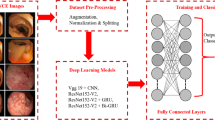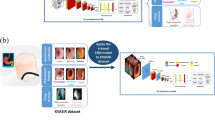Abstract
The human gastrointestinal (GI) system can be affected by various illnesses which results in the death of about two million patients globally. Endoscopy helps to detect such diseases as identifying these abnormalities in GI tract endoscopic images is crucial for therapy and follow-up decisions. However, clinicians require adequate time to examine such follow-ups that hinders manual diagnosis. As a result, the aim of the study is to detect and classify various gastric based diseases using deep transfer learning models such as DenseNet201, EfficientNetB4, Xception, InceptionResNetV2, and ResNet152V2, which have been assessed on the basis of precision, loss, accuracy, F1 score, root mean square error, and recall. In this study, Kvasir’s dataset has been used, which is divided into five categories: dyed-lifted polyps, esophagitis, normal cecum, dyed resection margins, and normal colon of endoscopic images. All the images are enhanced by removing the noise before being sent into the deep transfer learning algorithms. During experimentation, it has been analyzed that to detect dyed-lifted polyps, Inception ResNetV2 obtained the highest testing accuracy by 97.32%. On the other hand, Xception model efficiently detects dyed resection margins, esophagitis, normal cecum, and normal colon by computing the best testing accuracy of 95.88%, 96.88%, 97.16%, and 98.88%, respectively.














Similar content being viewed by others
Data availability
Not applicable.
References
Paul Y, Hickok E, Sinha A, Tiwari U, Mohandas S, Ray S, Bidare PM (2018) Artificial intelligence in the healthcare industry in India. The Centre for Internet and Society, India.
Mirbabaie M, Stieglitz S, Frick NR (2021) Artificial intelligence in disease diagnostics: a critical review and classification on the current state of research guiding future direction. Heal Technol 11(4):693–731
Dheir IM, Abu-Naser SS (2022) Classification of Anomalies in Gastrointestinal Tract Using Deep Learning. International Journal of Academic Engineering Research (IJAER), 6(3).
Kaur I, Sandhu AK, Kumar Y (2022) Artificial intelligence techniques for predictive modeling of vector-borne diseases, and its pathogens: a systematic review. Arch Comput Methods Eng 29:3741–3771. https://doi.org/10.1007/s11831-022-09724-9
Hernandez M (2016) Improving Foot Care and Kidney Disease Screening Through Implementation of American Diabetes Association Standards–2016 in The Primary Care Setting.
World Health Organization. Centre for Health Development, & World Health Organization. (2010). Hidden cities: unmasking and overcoming health inequities in urban settings. World Health Organization.
Furukawa A, Sakoda M, Yamasaki M, Kono N, Tanaka T, Nitta N et al (2005) Gastrointestinal tract perforation: CT diagnosis of presence, site, and cause. Abdom Imaging 30(5):524–534
Kumar Y, Gupta S, Singla R et al (2022) A systematic review of artificial intelligence techniques in cancer prediction and diagnosis. Arch Comput Methods Eng 29:2043–2070. https://doi.org/10.1007/s11831-021-09648-w
Öztürk S, Özkaya U (2020) Gastrointestinal tract classifica-tion using improved LSTM based CNN. Multimed Tools Appl 79(39):28825–28840
Agrebi S, Larbi A (2020) Use of artificial intelligence in infectious diseases. In Artificial intelligence in precision health (pp. 415–438). Academic Press.
Pogorelov K, Riegler M, Halvorsen P, Griwodz C, de Lange T, Randel KR, et al. (2017) A Comparison of Deep Learning with Global Features for Gastrointestinal Disease Detection. In MediaEval.
Gamage C, Wijesinghe I, Chitraranjan C, Perera I (2019) GI-Net: anomalies classification in gastrointestinal tract through endoscopic imagery with deep learning. In 2019 Moratuwa Engineering Research Conference (MERCon) (pp. 66–71). IEEE.
Iakovidis DK, Georgakopoulos SV, Vasilakakis M, Koulaouzidis A, Plagianakos VP (2018) Detecting and locating gastrointestinal anomalies using deep learning and iterative cluster unification. IEEE Trans Med Imaging 37(10):2196–2210
Zhou M, Bao G, Geng Y, Alkandari B, Li X (2014) Polyp detection and radius measurement in small intestine using video capsule endoscopy. In 2014 7th International Conference on Biomedical Engineering and Informatics (pp. 237–241). IEEE.
Sharif M, Attique Khan M, Rashid M, Yasmin M, Afza F, Tanik UJ (2021) Deep CNN and geometric features-based gastrointestinal tract diseases detection and classification from wireless capsule endoscopy images. J Exp Theor Artif Intell 33(4):577–599
Yuan Y, Meng MQH (2017) Deep learning for polyp recognition in wireless capsule endoscopy images. Med Phys 44(4):1379–1389
KahsayGebreslassie A, Hagos MT (2019) Automated gastrointestinal disease recognition for endoscopic images. In 2019 International Conference on Computing, Communication, and Intelligent Systems (ICCCIS) (pp. 312–316). IEEE.
Zeng X, Wen L, Liu B, Qi X (2020) Deep learning for ultrasound image caption generation based on object detection. Neurocomputing 392:132–141
Igarashi S, Sasaki Y, Mikami T, Sakuraba H, Fukuda S (2020) Anatomical classification of upper gastrointestinal organs under various image capture conditions using AlexNet. Comput Biol Med 124(6):103950
Ghatwary N, Zolgharni M, Ye X (2019) Early esophageal adenocarcinoma detection using deep learning methods. Int J Comput Assist Radiol Surg 14(4):611–621. https://doi.org/10.1007/s11548-019-01914-4
Cogan T, Cogan M, Tamil L (2019) MAPGI: accurate identification of anatomical landmarks and diseased tissue in gastrointestinal tract using deep learning. Comput Biol Med 111:103351
Nadeem et al. (2018) Nadeem S, Tahir MA, Naqvi SSA, Zaid M. Ensemble of texture and deep learning features for finding abnormalities in the gastro-intestinal tract. International Conference on Computational Collective Intelligence; Springer; 2018. pp. 469–478.
A Asperti, C Mastronardo, (2017) “The Effectiveness of Data Augmentation for Detection of Gastrointestinal Diseases from Endoscopical Images,” arXiv,.
Bhardwaj P, Bhandari G, Kumar Y et al (2022) An investigational approach for the prediction of gastric cancer using artificial intelligence techniques: a systematic review. Arch Comput Methods Eng 29:4379–4400. https://doi.org/10.1007/s11831-022-09737-4
Almanifi ORA, Razman MAM, Khairuddin IM, Abdullah MA, Majeed APA (2021) Automated Gastrointestinal Tract Classification Via Deep Learning and The Ensemble Method. In 2021 21st International Conference on Control, Automation and Systems (ICCAS) (pp. 602–606). IEEE.
Cario CL, Witte JS (2018) Orchid: a novel management, annotation and machine learning framework for analyzing cancer mutations. Bioinformatics 34(6):936–942
Gupta A, Koul A, Kumar Y (2022) Pancreatic Cancer Detection using Machine and Deep Learning Techniques. In: 2nd International Conference on Innovative Practices in Technology and Management (ICIPTM) (Vol. 2, pp. 151–155). IEEE.
Nadeem S, Tahir MA, Naqvi SSA, Zaid M (2018) Ensemble of texture and deep learning features for finding abnormalities in the gastro-intestinal tract. In: Nguyen NT, Pimenidis E, Khan Z, Trawiński B (eds) International Conference on Computational Collective Intelligence. Springer, Cham, pp 469–478
Gamage C, Wijesinghe I, Chitraranjan C, Perera I (2019) GI-Net: anomalies classification in gastrointestinal tract through endoscopic imagery with deep learning. In 2019 Moratuwa Engineering Research Conference (MERCon) (pp. 66–71). IEEE
Yan T, Wong PK, Choi IC, Vong CM, Yu HH (2020) Intelligent diagnosis of gastric intestinal metaplasia based on convolutional neural network and limited number of endoscopic images. Comput Biol Med 126:104026
Kumar Y, Gupta S (2023) Deep transfer learning approaches to predict glaucoma, cataract, choroidal neovascularization, diabetic macular edema, DRUSEN and healthy eyes: an experimental review. Arch Comput Methods Eng 30:521–541. https://doi.org/10.1007/s11831-022-09807-7
Gupta S, Kumar Y (2022) Cancer prognosis using artificial intelligence-based techniques. SN Comput Sci 3:77. https://doi.org/10.1007/s42979-021-00964-3
Kumar Y, Singla R (2022) Effectiveness of Machine and Deep Learning in IOT-Enabled Devices for Healthcare System. In: Ghosh U, Chakraborty C, Garg L, Srivastava G (eds) Intelligent Internet of Things for Healthcare and Industry. Springer, Cham, pp 1–19
Bansal K, Bathla RK, Kumar Y (2022) Deep transfer learning techniques with hybrid optimization in early prediction and diagnosis of different types of oral cancer. Soft Comput 26:11153–11184. https://doi.org/10.1007/s00500-022-07246-x
Koul A, Bawa RK, Kumar Y (2023) Artificial intelligence techniques to predict the airway disorders illness: a systematic review. Arch Comput Methods Eng 30:831–864. https://doi.org/10.1007/s11831-022-09818-4
Chaplot N, Pandey D, Kumar Y et al (2023) A comprehensive analysis of artificial intelligence techniques for the prediction and prognosis of genetic disorders using various gene disorders. Arch Comput Methods Eng. https://doi.org/10.1007/s11831-023-09904-1
Kanna GP, Kumar SJKJ, Parthasarathi P et al (2023) A review on prediction and prognosis of the prostate cancer and gleason grading of prostatic carcinoma using deep transfer learning based approaches. Arch Comput Methods Eng. https://doi.org/10.1007/s11831-023-09896-y
Kumar A, Kumar N, Kuriakose J et al (2023) A review of deep learning-based approaches for detection and diagnosis of diverse classes of drugs. Arch Comput Methods Eng. https://doi.org/10.1007/s11831-023-09936-7
Sisodia PS, Ameta GK, Kumar Y et al (2023) A Review of deep transfer learning approaches for class-wise prediction of alzheimer’s disease using MRI images. Arch Comput Methods Eng 30:2409–2429. https://doi.org/10.1007/s11831-022-09870-0
Musha A, Hasnat R, Al Mamun A, Ghosh T (2022). Deep Learning-Based Comparative Study to Detect Polyp Removal in Endoscopic Images. In International Conference on Emerging Smart Computing and Informatics (ESCI) (pp. 1–5). IEEE.
Kaur S, Kumar Y, Koul A et al (2023) A systematic review on metaheuristic optimization techniques for feature selections in disease diagnosis: open issues and challenges. Arch Comput Methods Eng 30:1863–1895. https://doi.org/10.1007/s11831-022-09853-1
https://my.clevelandclinic.org/health/articles/7040-gastrointestinal-diseases
https://www.niddk.nih.gov/health-information/digestive-diseases/digestive-system-how-it-works
Kaur D, Singh S, Mansoor W, Kumar Y, Verma S, Dash S, Koul A (2022) Computational intelligence and metaheuristic techniques for brain tumor detection through IoMT-enabled MRI devices. Wirel Commun Mob Computing. https://doi.org/10.1155/2022/1519198
Kumar Y, Koul A, Singla R, Ijaz MF (2022) Artificial intelligence in disease diagnosis: a systematic literature review, synthesizing framework and future research agenda. Journal of Ambient Intelligence and Humanized Computing, 1–28.
Petscharnig S, Schöffmann K, Lux M (2017) An Inception-like CNN Architecture for GI Disease and Anatomical Landmark Classification. In MediaEval.
Ahmed A (2022) Classification of Gastrointestinal Images Based on Transfer Learning and Denoising Convolutional Neural Networks. In: M Saraswat, S Roy, C Chowdhury, AH Gandomi (Eds) Proceedings of International Conference on Data Science and Applications (pp. 631–639), Springer, Singapore.
Yang S, Lemke C, Cox BF, Newton IP, Näthke I, Cochran S (2020) A learning-based microultrasound system for the detection of inflammation of the gastrointestinal tract. IEEE Trans Med Imaging 40(1):38–47
Funding
Not applicable.
Author information
Authors and Affiliations
Corresponding author
Ethics declarations
Conflict of interest
The authors declare no conflict of interest.
Additional information
Publisher's Note
Springer Nature remains neutral with regard to jurisdictional claims in published maps and institutional affiliations.
Rights and permissions
Springer Nature or its licensor (e.g. a society or other partner) holds exclusive rights to this article under a publishing agreement with the author(s) or other rightsholder(s); author self-archiving of the accepted manuscript version of this article is solely governed by the terms of such publishing agreement and applicable law.
About this article
Cite this article
Bhardwaj, P., Kumar, S. & Kumar, Y. A Comprehensive Analysis of Deep Learning-Based Approaches for the Prediction of Gastrointestinal Diseases Using Multi-class Endoscopy Images. Arch Computat Methods Eng 30, 4499–4516 (2023). https://doi.org/10.1007/s11831-023-09951-8
Received:
Accepted:
Published:
Issue Date:
DOI: https://doi.org/10.1007/s11831-023-09951-8




